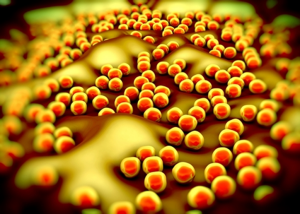Facilitating horizontal gene transfer between predator and prey bacteria
The development of antibiotic resistance in bacteria is a global health issue that limits the prevention and treatment of infections. Patients infected with antibiotic-resistant bacteria have worse clinical outcomes with a higher risk of death and consume more healthcare resources than patients infected with non-resistant strains of the same bacteria. Given the significant clinical and economic implications of antibiotic resistance, understanding the mechanisms that allow bacteria to become resistant is important. A recent publication in Cell Reports describes a strategy by bacteria to acquire genetic material, and potentially antibiotic resistance, from competing bacteria.
 The type VI secretion system
The type VI secretion system
Bacteria are able to influence their surrounding environment by shuttling a variety of proteins out of the cell using a number of secretion systems. Some secretion systems exist in almost all bacteria and release a wide range of proteins, while others are present in only a few types of bacteria and release specialized proteins. In pathogenic bacteria, these secretion systems may confer an advantage to manipulate a host or destroy competing bacteria in the same environment. One of the more recently discovered secretion systems is the type VI secretion system (T6SS). It has been identified in 25% of sequenced Gram-negative bacteria and facilitates the transfer of toxins and the direct killing of competitors. In Vibrio cholerae, T6SS has been demonstrated to promote survival and allow horizontal gene transfer, the transfer of DNA between bacteria. To further study the role of T6SS in cell lysis and horizontal gene transfer, Dr. Marek Basler at the University of Basel studied the interaction of Acinetobacter baylyi, a bacterium related to the multi-drug resistant Acinetobacter baumannii, with Escherichia coli.
T6SS effectors selectively induce cell lysis and horizontal gene transfer
T6SS is one of the few secretion systems in Gram-negative bacteria that is contact dependent and believed to be involved in bacterial predator-prey interactions. A. baylyi, a predator bacteria expressing T6SS, was incubated with a prey bacteria, E. coli. During this predator-prey interaction, Basler and colleagues identified five different proteins, or effectors, that A. baylyi can release through the TS66. Interestingly, the different effectors led to varying degrees of cell lysis in E. coli which correlated to the level of horizontal gene transfer to A. baylyi. These findings indicate that cell lysis is needed for horizontal gene transfer and having a variety of effectors and the ability to lyse different species of bacteria may confer an advantage in a new environmental niche. Furthermore, the TS66 could be an effective tool to promote antibiotic resistance between bacteria and may be responsible for the development of the multi-drug resistant Acinetobacter baumannii.
Bacteriology and infectious disease research
Do you work in bacteriology or infectious disease research? Our catalog has a variety of proteins, antibodies and cells lines associated with bacteriology and infectious disease research.


